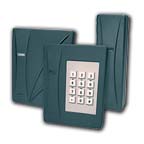
In addition to traditional keypad designs, newer units aim at surviving more rugged environments. Some now emphasize the need to meet the aesthetics of the building or corporation in which they work. And then there’s the growing attraction for keypads to multi-task, working with access cards or even biometrics.
Keypads were among the early mechanical and then electronic security devices, with push buttons first driving a door bolt, much like a combination lock. Originally developed for government and military use, including the then breakthrough scrambling keypad, today the devices guard entrances to office buildings, corporate data centers, after-hour school and college facilities, parking garages and even worker and equipment lockers.

Evolution from Mechanical to Electronic
Over the years, the devices have – along with other industry technology – evolved into flexible electronic and computer-controlled keypads.Of course, keypads can protect a single door in stand-alone applications. But some computer-controlled units boast local intelligence thanks to a microcomputer as well as a level of on-board memory. These units handle multiple users and hold an audit trail.
Input-output capability allows an installer to update the intelligence or the end-user to add authorized users while uploading an audit trail to a personal computer or incident analysis software.
A stand-alone keypad working with a cylindrical lockset, for example, now comes in a variety of models to handle user capacities ranging from a handful of people to hundreds. Advances now permit individual keypads to be programmed through the pad itself or computer-programmed. Some units permit a secured infrared transmission device to do the programming.
Developments also have boosted event history capability and battery life. End-users now expect group features for management and user levels as well as time zone and event scheduling.
End-user Needs Expand
Lately, however, the emphasis has shifted to looks, ruggedness of the unit itself, networking or extending the life of keypads by combining them with access cards, especially proximity and smart cards, as well as biometrics, such as finger and hand geometry.No doubt, access keypads now network among themselves to handle numerous doors and facilities or they can hang from an integrated security system’s local area or wide area network. Better yet for some applications, there’s networkable software that creates “virtual†IP-based keypads with the ability to control and monitor via an Internet browser.
Ruggedness is an essential with many end-users and applications. Manufacturers have addressed this need in basically two ways: through the housing and by the way the keypad operates.
The standard plastic mechanical readers are often less tough and may be less secure than all-metal, non-mechanical solutions newer to the market. To some buyers, metal-housed keypads appeal on the basis of aesthetics. For example, building owners and managers often look for keypads that can blend into the metal and glass doors in today’s urban and suburban office buildings.
Specific to the operation of the keys, piezoelectric pads, according to some systems integrators and installers, can outperform membrane, conductive rubber and mechanical approaches.
Multiple-technology keypads indicate another important trend. This development comes from two directions: keypad makers are adding card and biometrics capabilities while card reader makers are adding keypads.
The bottom line is that there are two ways to be identified and verified locally: at the access control panel or locally through a proximity card, smart card or biometrics.
Those old keypad dogs, indeed, have learned a number of new tricks.
Sidebar
Why Are Keypads Popular?
Four primary reasons keypads have remained popular for years are:- Keypads are easy to use.
- Some keypads can complement mechanical keys and keyways in a smooth transition.
- The keypad approach can have cost advantages over card access systems.
- As end-users seek higher levels of security, keypads easily integrate with scrambling, proximity and smart cards as well as a diversity of biometrics.
Sidebar
Elements Important to End-users
The number of combinations available, either locally or centralized elsewhere, determine the number of users a keypad or system of keypads can accommodate – as well as the strength of the pad if an unauthorized person starts tapping in numbers.Frequent code changes can increase security. The down side is the higher degree of administration required, because security must get the new codes to the employees using the keypad.
Scrambling devices move around the location of the keys so that someone peeping from a distance cannot grab the code based on the position of the keys. Multiple technologies in the keypad also increase security.
A time penalty can deactivate the system when an incorrect code or series of mistakes are entered. Alarming rules can be used on certain errors.